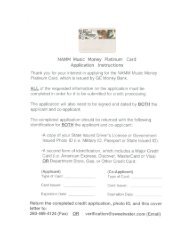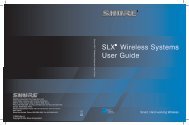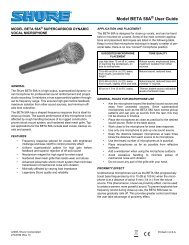Create successful ePaper yourself
Turn your PDF publications into a flip-book with our unique Google optimized e-Paper software.
Effects List<br />
49: MULTI TAP DELAY<br />
This effect provides four delays. Each of the Delay Time parameters<br />
can be set to a note length based on the selected tempo. You can also<br />
set the panning and level of each delay sound.<br />
fig.MFX-49<br />
L in<br />
R in<br />
Parameter Value Description<br />
Delay 1–4 Time<br />
Delay 1<br />
Feedback<br />
HF Damp<br />
This is a reverse delay that adds a reversed and delayed sound to the<br />
input sound. A tap delay is connected immediately after the reverse<br />
delay.<br />
fig.MFX-50<br />
0–2600 ms,<br />
note<br />
-98– +98%<br />
200–8000 Hz,<br />
BYPASS<br />
Adjusts the time until Delays 1–4 are<br />
heard.<br />
Adjusts the amount of the delay sound<br />
that’s fed back into the effect. Negative (-)<br />
settings invert the phase.<br />
Adjusts the frequency above which sound<br />
fed back to the effect is filtered out. If you<br />
don’t want to filter out any the high frequencies,<br />
set this parameter to BYPASS.<br />
Delay 1–4 Pan L64–63R Stereo location of Delays 1–4<br />
Delay 1–4 Level 0–127 Output level of Delays 1–4<br />
Low Gain -15– +15 dB Gain of the low frequency range<br />
High Gain -15– +15 dB Gain of the high frequency range<br />
Balance<br />
D100:0W–<br />
D0:100W<br />
Level 0–127 Output level<br />
50: REVERSE DELAY<br />
L in<br />
R in<br />
Volume balance between the direct sound<br />
(D) and the effect sound (W)<br />
Parameter Range Explanation<br />
Threshold 0–127<br />
Rev Delay Time<br />
Rev Delay<br />
Feedback<br />
Feed<br />
back<br />
Rev Delay HF<br />
Damp<br />
Rev Delay Pan<br />
Multi Tap Delay<br />
Feedback<br />
Delay 1<br />
Delay 2<br />
Rev. Delay<br />
0–1300 ms, note<br />
-98– +98%<br />
200–8000 Hz,<br />
BYPASS<br />
L64–63R<br />
Rev Delay Level 0–127<br />
Delay 3<br />
Delay 4<br />
Balance D<br />
Balance D<br />
Rev<br />
D1<br />
Delay<br />
D2<br />
D3<br />
2-Band<br />
EQ<br />
Balance W<br />
Balance W<br />
2-Band<br />
EQ<br />
2-Band<br />
EQ<br />
2-Band<br />
EQ<br />
L out<br />
R out<br />
Volume at which the reverse delay<br />
will begin to be applied<br />
Delay time from when sound is<br />
input into the reverse delay until<br />
the delay sound is heard<br />
Proportion of the delay sound<br />
that is to be returned to the input<br />
of the reverse delay (negative<br />
values invert the phase)<br />
Frequency at which the high-frequency<br />
content of the reverse-delayed<br />
sound will be cut (BYPASS:<br />
no cut)<br />
Panning of the reverse delay<br />
sound<br />
Volume of the reverse delay<br />
sound<br />
L out<br />
R out<br />
Parameter Range Explanation<br />
Delay 1 – 3 Time<br />
Adds a shuffle to the delay sound, giving the sound a bouncy delay<br />
effect with a swing feel.<br />
fig.MFX-51<br />
0–1300 ms, note<br />
Delay 3 Feedback -98– +98%<br />
Delay HF Damp<br />
Delay 1 Pan’,<br />
‘Delay 2 Pan<br />
Delay 1 Level’,<br />
‘Delay 2 Level<br />
Low Gain<br />
High Gain<br />
200–8000 Hz, BYPASS<br />
L64–63R<br />
Delay time from when sound is<br />
input into the tap delay until the<br />
delay sound is heard<br />
Proportion of the delay sound<br />
that is to be returned to the input<br />
of the tap delay (negative values<br />
invert the phase)<br />
Frequency at which the low-frequency<br />
content of the tap delay<br />
sound will be cut (BYPASS: no<br />
cut)<br />
Panning of the tap delay sounds<br />
0–127 Volume of the tap delay sounds<br />
-15– +15 dB<br />
-15– +15 dB<br />
Balance D100:0W–D0:100W<br />
Level 0–127 Output volume<br />
51: SHUFFLE DELAY<br />
L in<br />
R in<br />
Parameter Value Description<br />
Delay Time<br />
Shuffle<br />
Rate<br />
0–2600 ms,<br />
note<br />
0–100%<br />
Acceleration 0–15<br />
Feedback -98– +98%<br />
HF Damp<br />
200–8000 Hz,<br />
BYPASS<br />
Amount of boost/cut for the lowfrequency<br />
range<br />
Amount of boost/cut for the highfrequency<br />
range<br />
Volume balance of the original<br />
sound (D) and delay sound (W)<br />
Adjusts the time until the delay sound is<br />
heard.<br />
Adjusts the ratio (as a percentage) of the<br />
time that elapses before Delay B sounds relative<br />
to the time that elapses before the Delay<br />
A sounds.<br />
When set to 100%, the delay times are<br />
the same.<br />
Adjusts the speed which the Delay Time<br />
changes from the current setting to its specified<br />
new setting.<br />
Adjusts the amount of the delay that’s fed<br />
back into the effect. Negative (-) settings invert<br />
the phase.<br />
Adjusts the frequency above which sound<br />
fed back to the effect is filtered out. If you<br />
don’t want to filter out any high frequencies,<br />
set this parameter to BYPASS.<br />
Pan A/B 0–127 Stereo location of Delay A/B<br />
Level A/B 0–127 Volume of delay A/B<br />
Low Gain -15– +15 dB Gain of the low frequency range<br />
High Gain -15– +15 dB Gain of the high frequency range<br />
Balance<br />
Feedback<br />
Delay<br />
D100:0W–<br />
D0:100W<br />
Delay A<br />
Delay B<br />
Level 0–127 Output level<br />
A<br />
B<br />
2-Band<br />
EQ<br />
2-Band<br />
EQ<br />
Volume balance between the direct sound<br />
(D) and the effect sound (W)<br />
L out<br />
R out<br />
73
















